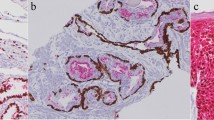ABSTRACT
Background
Reported incomplete excision rates vary widely. This study described a single center's treatment of basal cell carcinoma (BCC) and squamous cell carcinomas (SCC) of the head and neck and investigated possible causes of incomplete excision.
Methods
All excised BCCs and SCCs in 2011 were included into the study. Patients were identified by the diagnostic (diagnosis-related group (DRG)) codes from DC44.0 to DC44.4. A total of 437 patients were treated for 516 skin lesions.
Results
Mean age was 71.4 years and the male–female ratio was 1.29. Incomplete tumor removal was found in 11 % of all cases. Four significant factors were identified to predict incomplete excision, including age >75 years (relative risk (RR) = 14.8 % (95 %-CI: 5.8–24.7 %)), BCC tumor size above 1.5 cm (RR = 17.1 % (95 %-CI: 3.7–28.7 %)), lack of sufficient excision margin in SCC (<6 mm) (RR = 17.1 % (95 %-CI: 0.1–36.9 %)) and lack of frozen sectioning in high-risk areas (RR = 16.9 % (95 %-CI: 7.5–27.2 %)). Neither gender, tumor type, histological subtype, biopsy prior to surgery, tumor location nor surgeon grade predicted incomplete excision.
Conclusions
Head and neck BCCs, and SCCs are difficult to treat, and the need for complete tumor excision is mandatory prior to reconstruction. Our findings showed that causes of incomplete excision could be identified. With this knowledge, we are able to optimize our quality of treatment, patient satisfaction, and finally, the cost/effectiveness of our department.
Level of Evidence: Level III, prognostic/risk study.



Similar content being viewed by others
References
Manternach T, Housman TS, Williford PM et al (2003) Surgical treatment of nonmelanoma skin cancer in the medicare population. Dermatol Surg 29:1167–1169
Rieger KE, Linos E, Egbert BM, Swetter M (2010) Recurrence rates associated with incompletely excised low-risk nonmelanoma skin cancer. J Cutan Pathol 37:59–67
Thomas DJ, King AR, Peat BG (2003) Excision margins for non-melanom skin cancer. Plast Reconstr Surg 112:57–63
Trakatelli M, Ulrich C, Marmol D, Euvard S, Stockfleth E, Abeni D (2007) Epidemiology of nonmelanoma skin cancer (NMSC) in Europe: accurate and comparable data are needed for effective public health monitoring and interventions. Br J Dermatol 156(suppl 3):1–7
Seretis K, Thomaidis V, Karpourzis A, Tamikolakis D, Tsamis I (2010) Epidemiology of surgical treatment of nonmelanoma skin cancer of the head and neck in Greece. Dermatol Surg 36:15–22
Fortuin S, Kadouch DJM, Kadouch JA et al (2013) Use of an audit to improve surgical treatment of fascial basal cell carcinoma. Eur J Plast Surg 36:1–6
Stolle LB, Kjerkegaard UK (2013) A single center retrospective study on 959 excisions of non-melanoma skin cancer in 2011. J Plast Reconstr Aesthet Surg 66:1630–1632
Dubas LE, Ingraffea A (2013) Non melanoma skin cancer. Facial Plast Surg Clin N Am 21:43–53
Schmults CD, Karia PS, Carter JB, Han J, Qureshi AA (2013) Factors predictive of recurrence and death from cutaneous squamous cell carcinoma: a 10-year, single-institution cohort study. JAMA Dermatol 149:541–547
Griffiths RW (1999) Audit of histological incomplete excised basal cell carcinoma: recommendations, for management by re-excision. Br J Plast Surg 52:24–28
Codazzi D, Van Der Velden J, Carminati M et al (2013) Positive compared with negative margins in a single-centre retrospective study on 3957 consecutive excisions of basal cell carcinomas. Associated risk factors and preferred surgical management. J Plast Surg Hand Surg. doi:10.3109/2000656X.2013.800526
Kumar P, Orton CI, McWilliam LJ, Watson S (2000) Incidence of incomplete excision in surgical treated basal cell carcinomas: a retrospective clinical audit. Br J Plast Surg 53:563–566
Hansen C, Wilkinson D, Hansen M, Soyer HP (2009) Factors contributing to incomplete excision of nonmelanoma skin cancer by Australian general practitioners. Arch Dermatol 145:1253–1260
Brantsch K, Meisner C, Schönfisch B et al (2008) Analysis of risk factors determining prognosis of cutaneous squamous-cell carcinoma: a prospective study. Lancet Oncol 9:713–720
Gurudutt VV, Genden EM (2011) Cutaneous squamous cell carcinoma of the head and neck. J Skin Cancer. doi:10.1155/2011/502723
Ang P, Tan AWH, Goh CL (2004) Comparison of completely versus incompletely excised cutaneous squamous cell carcinomas. Ann Acad Med Singap 33:68–70
Kim RH, Armstrong AW (2012) Nonmelanoma skin cancer. Dermatol Clin 30(1):125–139
Bogdanov-Berezovsky A, Cohen AD, Glesinger R, Cagnano E, Krieger Y, Rosenberg L (2004) Risk factors for incomplete excision of basal cell carcinomas. Acta Derm Venereol 84:44–47
Su SY, Giorlando F, Ek EW, Dieu T (2007) Incomplete excision of basal cell carcinoma: a prospective trial. Plast Reconstr Surg 120:1240–1248
Bogelund FS, Philipsen PA, Gniadecki R (2007) Factors affecting the recurrence rate of basal cell carcinoma. Acta Derm Venereol 87:330–334
Kumar P, Watson S, Brain AN et al (2002) Incomplete excision of basal cell carcinoma: a prospective multicentre audit. Br J Plast Surg 55:616–622
Farhi D, Dupin N, Palangié A, Carlotti A, Avril MF (2007) Incomplete excision of basal cell carcinoma: rate and associated factors among 362 consecutive cases. Dermatol Surg 33:1207–1214
Kjerkegaard UK, Stolle LB (2013) Excision of nonmelanoma skin cancer by a resident: how safe is it? Eur J Plast Surg 36:783–788
Codazzi D, Van der Velden J, Carminati M et al (2012) A single-center retrospective study on 3,957 consecutive excisions of basal cell carcinomas. BCC behavior patterns: retrospective statistical analysis. Eur J Plast Surg 35:293–298
Lane JE, Kent D (2005) Surgical margins in the treatment of nonmelanoma skin cancer and Mohs micrographic surgery. Curr Surg 62:518–526
Rowe DE, Carroll RJ, Day CL Jr (1989) Mohs surgery is the treatment of choice for recurrent (previously treated) basal cell carcinomas. J Dermatol Surg Oncol 15:424–431
Conflict of interest
None
Author information
Authors and Affiliations
Corresponding author
Rights and permissions
About this article
Cite this article
Kjerkegaard, U.K., Stolle, L.B. Incomplete excision of non-melanoma skin cancer of the head and neck: can we predict failure?. Eur J Plast Surg 37, 141–146 (2014). https://doi.org/10.1007/s00238-013-0916-2
Received:
Accepted:
Published:
Issue Date:
DOI: https://doi.org/10.1007/s00238-013-0916-2




